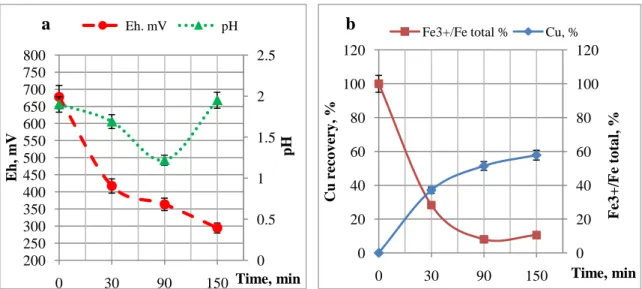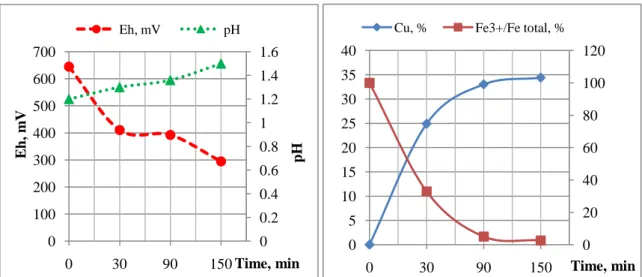1
Title. Bioleaching of metals from e-waste using
immobi-lized biomass of mesophilic Acidithiobacillus
ferroox-idans.
Arevik Vardanyan1*, Narine Vardanyan1, Stoyan Gaydardzhiev2
1
Institute of Microbiology of SPC «Armbiotechnology» of NAS of Armenia, Gyurjyan 14, 0056, Ye-revan, Armenia
2
GeMMe-Mineral Processing and Recycling, University of Liege, Allée de la Decouverte 9, Sart Ti l-man, 4000 Liege, Belgium
*Correspondence: avivardan@gmail.com (A. Vardanyan).
Abstract: Among the secondary post-consumption wastes, e-wastes represent the fastest growing waste stream in the world being heterogeneous and diverse in terms of structure and composition. Consequently, it is difficult to feed such waste into conventional recycling streams. Biometallurgy could prove a competitive and applicable technique for recovering valuable metals from these materials. The objective of the study is to test the feasibility of biometallurgy for recycling secondary raw materials, rendering the presently uneconomic raw materials economically viable, thus contributing directly to the circular economy. Long-term objective is to study the peculiarities of bioleaching of secondary raw materials, reveal the role of bacteria in these processes and develop the concept on the mechanism of bioleaching of secondary raw materials. Comparative chemical leaching of printed circuit boards (PCBs) by ferric sulfate Fe2O12S3xH2Osolution and biogenic Fe3+obtained by immobilized biomass of
Acidithiobacillus ferrooxidans 61 (Armenia) and Acidithiobacillus GR1 (Bulgaria) has been performed. The intensity of zero valent copper oxidation was correlated to the ratio of Fe3+/Fe2+ ions in the solution. It was revealed that recovery of metals from PCBs by biogenic Fe3+ occurred 2-3 times more intensively than that by Fe2O12S3xH2Osolution. The use of
Fe2O12S3xH2Osolution for leaching of PCBs resulted in intensive precipitation of Fe 3+
and generation of jarosite, while in case of biogenic Fe3+ the amount of jarosite was significantly lower. It is supposed that Fe3+ in biogenic solution is mainly in the form of complexes with organic compounds produced by bacteria, which prevent its precipitation as jarosite. It is a s-sumed that chemical leaching by biogenic Fe3+ integrated into the processes of leaching of PCB's may contribute to intensification of extraction of copper and other valuable metals from different secondary resources.
2
Keywords:
Printed circuit boards (PCBs), Acidithiobacillus ferrooxidans, Biogenic ferric iron
solution, Leaching
1. Introduction
Recovering metals from e-waste is potentially more energy efficient than recovering them from mineral raw materials. However, e-wastes are highly complex in terms of structure and composition and comprise many individual sub-components but the majority of the value is in the PCBs. For example many of the ‘critical” metals are found in non-negligible amount in e-wastes and recent estimates showed that on average 90% of the intrinsic economic value of PCBs is in the precious metals that they contain [1]. PCB’s are among the most complex sub-components of e-waste and most difficult to reprocess, hence it is difficult to feed such waste into conventional recycling streams. Usually after disassembling and upgrading, the recovered materials are re-treated or purified using pyrometallurgical or hydrometallurgical processes or combination between both. The bio-hydrometallurgy which has its nature-doing roots using mi-croorganisms to enhance the dissolution of metals from mineral ores could offer viable altern a-tive to the classical hydrometallurgy by avoiding the use of corrosive chemicals (acids, bases). Its generic principles have recently stimulated a research in metals recovery from high value secondary sources (e-wastes, catalysts), but systematic work on zero-valent metals bio-leaching from materials with complex composition has been done rather sporadically. This work aims to fill some of these gaps by studying key biological characteristics of the leaching system with the final aim to understand the role which the MO play in boosting the bio-leaching efficiency through increased IOR (iron oxidation rate) and improved resistivity. In bioleaching metals, the regeneration of the leaching solutions is considered to be an important phase for the development of an efficient technology [2-4]. The regeneration of leaching liquors actually results in reduction of Fe (III), as the key component of leaching liquors is ferric ion (Fe (III)) which represents a strong oxidizer for sulfide minerals. At present regeneration of ferric ion in operating leaching technologies is realized by chemical methods mainly by chlorine, ozone, hydrogen peroxide which renders the process more complicated and cost inefficient. The use of microo rganisms al-lows simplifying the process of regeneration of leaching solutions and significantly decreases cost as microorganisms are considered to be unexhausted catalysts. On the other hand, immob i-lization of microorganisms on natural carriers will contribute to the intensification of r egenera-tion of ferric ion. By increasing microbial biomass density it will significantly allow to enhance conversion rate of Fe2+/Fe3+.
2. Materials and methods
2-1. Culture condition and immobilization
At. ferrooxidans 61 (KM819692) used in this study were previously isolated from AMD in Ar-menia (Vardanyan et al., 2016) and Acidithiobacillus sp. GR1 - from Bulgaria. Both cultures were grown at a temperature of 30-35ºC in 9K medium [5] using 18g/L FeSO4x7H2O as energy source.
3
For immobilization processes as a carrier FISH biomass (biopur) were used.
2-2. Determination of metals
Aliquot samples were taken during leaching experiments and analyzed by ICP-OES and atomic absorption for determination of Al, Zn, Fe and Cu. Ferrous iron (Fe2+) was determined by a redox reaction using potassium chromate (K2Cr2O7).
2-3. Bioleaching of PCB’s
The leaching experiments were performed in glass tank at 110 ºC at 500 rpm stirring. pH was controlled with 10N H2SO4, Eh - by the ferric iron and ferrous iron ratio. The leaching
expe-riments were performed by biogenic and chemical solutions of FeSO4x7H2O. For obtaining
chemical ferric iron Fe2O12S3xH2O(84g/L) saltsolution was used. Biogenic ferric iron was
ob-tained by the oxidation of ferrous iron (Fe (II)) by immobilized on biopur of At. ferrooxidans 61 and Acidithiobacillus sp. GR1.
3. Results and Discussions
For abiotic test 800 mL biogenic Fe3+ obtained by GR1 (18 g/L Fe2+) were used for leach-ing of 4% PCB (32g). The initial pH of experiment was 1.95, Eh was 677.5. The experiment was performed under pressure at 110C temperature and 500 rpm conditions.
As shown in the Fig. 1b, the leaching reactions mainly occurred at the first 1.5 h. Almost 50% Cu was dissolved (Fig. 1).
In case of using of chemical solution of Fe3+ in leaching experiments at the same conditions, copper recovery was 35% after 150 min (Fig. 2).
Fig. 1. Evaluation of pH, Eh parameters (a), copper recovery and ferric iron proportion (b) in the abiotic leaching of PCBs 0 0.5 1 1.5 2 2.5 200 250 300 350 400 450 500 550 600 650 700 750 800 0 30 90 150 pH E h, m V Time, min Eh. mV pH 0 20 40 60 80 100 120 0 20 40 60 80 100 120 0 30 90 150 F e3 +/F e to ta l, % Cu re co v er y , % Time, min Fe3+/Fe total % Cu, %
b
a
4
Fig. 2. Evaluation of pH, Eh parameters (a), copper recovery and ferric iron proportion (b) in the abiotic leaching of PCBs by chemical solution of Fe3+.
4. Conclusion
Thus, Acidithiobacillus ferrooxidans 61 and Acidithiobacillus sp. GR1 immobilized on bio-pur can be prospective to be applied in the technological processes for rapid regeneration of ox i-dizer – Fe (III). It can be concluded that leaching of PCB's with Fe (III) solution obtained by the immobilized cells of Aacidithiobacillus sp. GR1 allows to increase on average 2-3 times the ex-traction of iron and copper, 1.5 times Zn, 4 times Al from PCB's. Chemical oxidation of PCB's by biogenic ferric iron Fe(III) obtained by the immobilized biomass of CM integrated into bi o-hydrometallurgical technology allows significantly increasing the efficiency of subsequent b i-oleaching process and the extent of recovery of copper, zinc etc. from ores and refractory con-centrates.
Acknowledgement: Arevik Vardanyan acknowledges gratefully the FEMS Grant
(ID#FEMS-RG-2016-0104). References
1. Cui, J. and Zhang, L., 2008. Metallurgical recovery of metals from electronic waste: A review, in: Kumar, S., Luda, M.P., (Eds), Integrated Waste Management. InTech, pp. 285-298.
2. Das, T., Chaudhury, G.R., 2006. Iron Oxidation Studies with Immobilized Cells of Acidithi-obacillus ferrooxidans. J. Scientific Industrial Research. 65, 594-598.
3. Ginsburg. M.A., Penev. K., Karamanev. D., 2009. Immobilization and Ferrous Iron Biooxida-tion Studies of a Leptospirillum sp. Mixed-cell Culture. Mineral Engineering. 22, 140-148. 4. Vardanyan A.K., Markosyan L.S., Vardanyan N.S. Immobilization of new isolated iron
oxi-dizing bacteria on natural carriers // Advanced Materials Research, 2013, Vol. 825, p. 388-391.
5. Silverman, M.P., Lundgren, D.G., 1959. Studies on the chemoautotrophic iron bacterium Ferrobacillus ferrooxidans: I. An improved medium and a harvesting procedure for securing high cell yields. Journal of bacteriology. 77, 642.
0 0.2 0.4 0.6 0.8 1 1.2 1.4 1.6 0 100 200 300 400 500 600 700 0 30 90 150 pH E h, m V Time, min Eh, mV pH 0 20 40 60 80 100 120 0 5 10 15 20 25 30 35 40 0 30 90 150 Time, min

